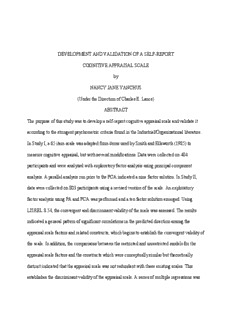Table Of ContentDEVELOPMENT AND VALIDATION OF A SELF-REPORT
COGNITIVE APPRAISAL SCALE
by
NANCY JANE YANCHUS
(Under the Direction of Charles E. Lance)
ABSTRACT
The purpose of this study was to develop a self-report cognitive appraisal scale and validate it
according to the stringent psychometric criteria found in the Industrial/Organizational literature.
In Study I, a 65 item scale was adapted from items used by Smith and Ellsworth (1985) to
measure cognitive appraisal, but with several modifications. Data were collected on 404
participants and were analyzed with exploratory factor analysis using principal component
analysis. A parallel analysis run prior to the PCA indicated a nine factor solution. In Study II,
data were collected on 803 participants using a revised version of the scale. An exploratory
factor analysis using PA and PCA was performed and a ten factor solution emerged. Using
LISREL 8.54, the convergent and discriminant validity of the scale was assessed. The results
indicated a general pattern of significant correlations in the predicted direction among the
appraisal scale factors and related constructs, which begins to establish the convergent validity of
the scale. In addition, the comparisons between the restricted and unrestricted models for the
appraisal scale factors and the constructs which were conceptually similar but theoretically
distinct indicated that the appraisal scale was not redundant with these existing scales. This
establishes the discriminant validity of the appraisal scale. A series of multiple regressions was
run to investigate the predictive patterns of relationships between the appraisal dimensions and
emotions. The general discussion includes the main conclusions of the study, the theoretical and
applied implications as well as the limitations of the study, and directions for future research.
INDEX WORDS: Cognitive appraisal, Emotion, Psychometrics, Scale development,
Construct validation, Convergent validity, Discriminant validity
DEVELOPMENT AND VALIDATION OF A SELF-REPORT
COGNITIVE APPRAISAL SCALE
by
NANCY JANE YANCHUS
B.A, Earlham College, 1991
M.A., The College of William and Mary, 2000
A Dissertation Submitted to the Graduate Faculty of The University of Georgia in Partial
Fulfillment of the Requirements for the Degree
DOCTOR OF PHILOSOPHY
ATHENS, GEORGIA
2006
© 2006
Nancy J. Yanchus
All Rights Reserved
DEVELOPMENT AND VALIDATION OF A SELF-REPORT
COGNITIVE APPRAISAL SCALE
by
NANCY JANE YANCHUS
Major Professor: Charles E. Lance
Committee: Karl W. Kuhnert
Leonard L. Martin
Craig A. Smith
Electronic Version Approved:
Maureen Grasso
Dean of the Graduate School
The University of Georgia
August 2006
DEDICATION
This work is dedicated to Anne, Plott, Pilgram, Sister, and B.K. Thank you for your
generosity, kindness, and support.
iv
ACKNOWLEDGEMENTS
I would like to thank Dr. Charles E. Lance for his outstanding guidance and support
throughout this process. You have been a phenomenal influence on my development as a
researcher and psychologist. Thanks for always making me strive to make my work the best
possible. I would like to thank Dr. Leonard L. Martin for his guidance throughout this process as
well. Your breadth of knowledge and insight was invaluable to the quality of the project. The
mentoring you have also provided will have an impact for a lifetime. In addition, I would like to
thank Dr. Craig A. Smith and Dr. Karl W. Kuhnert for their hard work and dedication toward the
improvement of this project. Thanks also to Tracy A. Lambert, whose support, friendship, and
humor throughout this process made it possible to make it through to the end and still remain a
dedicated researcher and teacher. Special thanks to my parents, Meg and Robert, as well as my
sisters, Sally and Susan, for their supportiveness during this time spent in graduate school.
Finally, it is with great love that I thank Dinah and Mr. Charlie for being there 24/7, day in and
day out, week after week, month upon month, and for many years by my side as I have pursued
this goal in spite of what might be considered difficult odds.
v
TABLE OF CONTENTS
Page
ACKNOWLEDGEMENTS.............................................................................................................v
LIST OF TABLES.........................................................................................................................ix
CHAPTER
1 INTRODUCTION.........................................................................................................1
Current Study............................................................................................................5
2 STUDY І......................................................................................................................10
3 METHOD....................................................................................................................12
Participants..............................................................................................................12
Materials and Measures...........................................................................................12
Procedure.................................................................................................................13
4 RESULTS....................................................................................................................15
Principal Components Analysis..............................................................................15
Correlation Analysis................................................................................................19
5 DISCUSSION..............................................................................................................21
6 STUDY II.....................................................................................................................22
7 METHOD....................................................................................................................26
Participants..............................................................................................................26
Materials and Measures...........................................................................................26
Procedure.................................................................................................................28
vi
8 RESULTS....................................................................................................................29
Principal Component Analyses...............................................................................29
Convergent Validity Analyses.................................................................................34
Discriminant Validity Analyses..............................................................................41
Multiple Regression Analyses.................................................................................42
Post Hoc Analyses...................................................................................................43
9 DISCUSSION..............................................................................................................46
10 GENERAL DISCUSSION..........................................................................................50
Main Conclusions....................................................................................................51
Implications.............................................................................................................53
Limitations...............................................................................................................54
Future Directions.....................................................................................................55
REFERENCES..............................................................................................................................57
APPENDICES...............................................................................................................................65
A Comparison Items on the Dimensional Ratings Questionnaire (Smith and Ellsworth,
1985)........................................................................................................................66
B Internal Structure of the Nine Recovered Appraisal Scales
(Ellsworth & Smith, 1988a)....................................................................................68
C Internal Structure of the Nine Recovered Appraisal Scales (Ellsworth & Smith,
1988b)......................................................................................................................70
D Three-Part Cognitive Appraisal Survey.......................................................................72
E Revised 58-Item Cognitive Appraisal Scale................................................................78
vii
F Differential Emotions Scale – IV (DES) (Kotsch, Gerbing, & Schwartz, 1982)........82
G PANSAS – X (Watson & Clark, 1999).......................................................................84
H Procedural Justice Scale (Colquitt, 2001)....................................................................85
I Generalized Self-Efficacy Scale (Schwarzer & Jerusalem, 1995)...............................86
J Perceived Predictability Index
(Zvolensky, Eifert, Lejuez, Hopko, & Forsyth, 2000)............................................87
K The Causal Dimension Scale (Russell, 1982)..............................................................88
L Mindful Attention Awareness Scale (Brown & Ryan, 2003)......................................89
M Avoidance Subscale from the Ways of Coping Checklist – Revised
(Vitaliano, Russo, Carr, Maiuro, & Becker, 1985).................................................90
N Causal Uncertainty Scale (Adapted) (Weary & Edwards, 1994)................................91
O Need to Evaluate Scale (Jarvis & Petty, 1996)............................................................92
P Need for Cognition Scale – Short Form (Cacioppo, Petty, & Kao, 1984)..................93
Q Demographic Survey...................................................................................................94
R Comparison of Past Experience Descriptions from Retained and Discarded Data.....95
viii
Description:measure cognitive appraisal, but with several modifications. Data were A Dissertation Submitted to the Graduate Faculty of The University of Georgia in Partial. Fulfillment of the Requirements for the Degree. DOCTOR OF Thanks for always making me strive to make my work the best possible.

